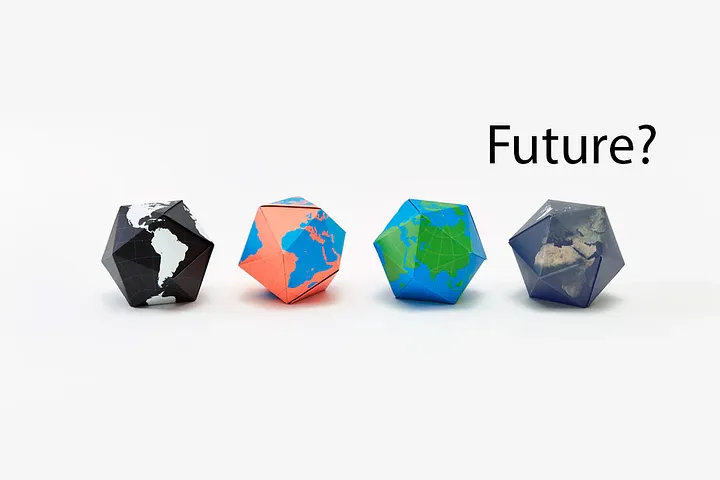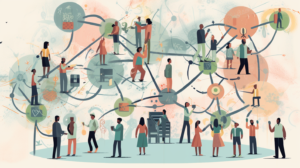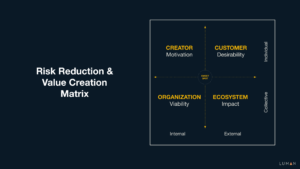Yesterday was future day. On last year’s future day, the pandemic was still the central theme. Now the news has shifted to humanity’s latest armed conflict — one many hadn’t thought possible so close to where only a hundred years ago we had hoped to have had the war that ended all wars.
Today, the future, and humanity’s future in particular, looks confusing at best, easily bleak, and most definitely uncertain.
So, what is happening on spaceship earth?
State of spaceship earth
While we marvel at the idiocy of the spaceships’ crew fighting each other, we know deep down, we have way more urgent issues to attend to. This new war is already causing streams of refugees, but we know we can expect significantly more to come due to rapid population growth, climate and weather changes. Meanwhile we continue to witness our own failures and that of our organizations to act in the face of the consequences of our past choices. Over 140 countries face at least one ecological threat by 2050, and the UN expects more than 1 billion people being displaced within 30 years. Maybe it’s not so far off to suggest that the primary future global cultural operating system will be born out of refugee culture, as Monica Byrne suggests in “The Actual Star”.
Whether through refugees, our international supply chains and global business, or even travel, we are integrating on a biological and cultural level amidst planetary titration. From viruses and bacteria to critters, all the way to human values and memes.
While many don’t have a grasp on even current technology, Web 2.0 and even more so Web 3.0 (including the already buzzword infamous Metaverse) will continue to create a new spatial understanding of the world and drive further planetary integration.
We see pictures of earth, we see nature, we see life, we see humanity, we see each other now, so we can no longer say we didn’t know, or can we?
Life is a fractal process
At all times we have all levels of consciousness from single cell to at least the most advanced human present on planet earth as each life unfolds in its own development. Within each lifetime, every human is learning to be alive, to integrate the past, become present, so they can create future. Today, the spectrum of humanity is stretched larger than ever before:
We have humans who life like our ancestors, who can’t read or write, walking for miles every morning just to fetch water; for some it’s still the middle ages where we kill each other over imagined gods; many still hold themselves to Victorian age values, or are stuck in 1980s Wall Street greed, while a few are already no longer just dreaming of spaceflight and colonizing distant planets, but are already sending their projectiles into space.
Wherever you find yourself on this spectrum, it is a fallacy to assume that level of consciousness from others, or assuming that another human has a similar grasp on reality as you do (see also false consensus effect).
That said, when we moved from analog to digital information transfer, something unique happened for the first time in human history.
Digital to analog — Innovation everywhere
Until now, innovation had always been localized due to the availability and speed of information. It spread through trade routes slowly, and sparking innovation in new places, old centers of innovation (and with that their empires) vanished, while new ones flourished.
Today, innovation can happen anywhere on planet earth. Any human with a $25 smart phone has access to pretty much all the digitized knowledge of humanity (firewalls forgone for a moment). While knowledge isn’t wisdom, the availability of knowledge allows for new experiences in places where they hadn’t been before — leading to learning and wisdom through application and sharing with each other at unprecedented speeds.
Today, we can learn anything. Faster than ever.
With learning comes a new level of awareness of self and our role in life.
A new awareness of self
We evolve in reflection of the technology we have created and the consciousness that created it. The internet was created under the influence of a new consciousness on the West Coast of California in the booming 60s. It first facilitated connection of individual nodes in ad hoc networks. That metaphor is now translating into how we can be human. Individuals, connected in global ad hoc networks. Organizing becomes more fluid enabled by these new capacities to network.
What we do with these networks, whether we play simulated — or real — war games, or collectively innovate the future of humanity, depends on the development of the individuals using these technologies.
Individual development is catching up en masse. As silly as it may seem, selfies are a means to become aware of one’s own individuality (the lower level version of that is a baby or mammal seeing themselves in a mirror for the first time — Narcissus’ pond experience of self as other).
As we are now being asked what avatars we want to use in a virtual world where we are unbound from our current physical limitations, we get to explore our own concepts of identity anew, whether it is in the domain of gender, our shadings, or our body shape (including extra limbs and imaginary, fantastical or alien bodies).
At the same time, we have pictures of earth from space and news from around the world. We see “other” in all its forms. We know that around the world there are other humans, some at different levels of development, with different cultural restraints and preferences, some we feel kinship towards more easily, others alienate us.
However, we cannot ignore that we are part of the human species, part of life, even. We are beginning to realize we are part of a larger whole, of this planet, which seems to be alive itself, as Lovelock already suggested in the 70s with his Gaia Hypothesis.
With that new awareness, we now get to ask ourselves how we want to contribute to the future.
Becoming creators anew
Every new wave of development has allowed humans to invent new ways of contributing to the whole. As we are looking at nearly 80% of repeatable processes in organizations being taken over by artificial intelligence and automation, we are also looking at the spatial web as a whole new playground for human creativity. More importantly even than the potentially escapist playing field of the metaverse, is the overlay of realities, mixed and augmented realities that can even bring us back to creating for the real world. Karl Schroeder in “Stealing World” paints a picture of reality, where individual contribution to the commons is gamified and integrated into overlays on existing reality, while externalities are personified in AI driven NPC characters, urging humanity toward real world regeneration.
Already today, we can imagine and create something in virtual space, and have it be printed in real life in a matter of hours. Additive manufacturing is not new, but 3D and even 4D printing will become increasingly important, especially now that the early creative part will become more accessible, and phygital will become more common.
Aligning with life
What solutions we create depends on whether we are focused on consumption (meaning taking away from future) or production (adding to future).
Every moment of transformation is also an opportunity for alignment:
If you take an iron rod, hold it vertically and hammer it, it will turn into a magnet. As all its particles get shaken up, they align themselves with the strongest electro-magnetic field, in this case the earth, causing the rod to act like a magnet.
Similarly, when humanity is in moments of transformation, shaken up by the events around us, we have an opportunity to align with earth, with life as such, and become magnets for creation.
With new awareness, and new awareness of self in the world comes new opportunity and invitation to take responsibility on a higher level.
Personal development is key
Awareness, responsibility, and ultimately the level of ownership we experience in life depends on our level of personal development. All life keeps growing and evolving. Otherwise, plants would stop growing, and animals would stop moving. As humans, we also continue to evolve. We are meant to keep learning.
Unfortunately, our factory focused education system has been more about instruction to ensure the appropriate human resources for the machine, than about actually educating individuals in their character development, as Humboldt and others originally intended.
All evil starts inside of me. We can never get rid of our demons, but we can learn to live above them. Each of us holds all of life and all of its potential — for better or worse — inside of us. Key is to actually hold each other accountable not just for what we do, but for how we show up in this world — and to who we can become as humans.
Since the majority of humans is not even on a self-authoring level of development, a level where they are making their own choices based on their values, rather than their addictions, whims or social conditioning, collective fast-tracked personal development is key to our future.
Learning to love uncertainty
One key step in personal development is learning to understand and use your emotions. We are wired to move away from pain and move toward pleasure. Much of our system is built toward avoiding danger. The amygdala inside the limbic system of our brain, the emotional center, is constantly scanning for potential threat. Once activated, it triggers freeze, flight, fight, fawn responses much older than our conscious awareness of self.
Our brains are wired to hate uncertainty. Not knowing activates the amygdala, which release ~1400 chemicals into our system, preparing us for those four key responses, including sending most of our blood to our arms and legs so we can run or fight — which doesn’t leave much for the brain or thinking.
In a world of uncertainty, this can mean continuous stress. It is not surprising that issues of stress, anxiety, and related issues have been on the rise in modern times.
To actively create the future, we have to learn to overcome our fear, especially our fear of divergence, of novelty.
Diversity
New information is scary. Our fear responses get triggered by anything that is different from what we know.
New is also what is needed. We need many new and different perspectives on the table if we want to create the future that works for most of humanity. We have to move through a polytopia, if we want to create a eutopia.
If it doesn’t work for all of humanity, it’s not working.
Of course, this is a ridiculous goal. We will never be able to integrate all the diversity on this planet, at least not until we understand that any higher value is only ever an approximation, that we can move toward freedom, justice, equity, that there are no perfect solutions, but that it will be a continuous process of improvement.
Embracing perpetual beta
Life is in perpetual beta. One more thing our technology has been reflecting back to us is that life is a process. There is no perfect app, all apps are in perpetual beta now. This is also true for us as humans. We seem to be verbs, as Buckminster Fuller put it.
Tempora mutantur, et nos mutamur — times change, and we change with them. For us to change, we get to embrace both aspects of being a human: we are both creative beings, capable of integrating and synthesizing new information, and accountable executers, who can do things repeatedly and excel at that.
Humans naturally want to do both: explore and exploit — if we want ambidexterity in organizations, we have to have ambidexterity in individuals first. As such, we get to understand that the idea that learnings is finished after school or university actually diminishes us as individuals.
We are all learners, doers, teachers, creators.
Why? How? What?
So, what do we do with all that? How do we find direction and a sense of competence in an ever changing world? How do we create a sense of belonging to something larger than ourselves that inspires us to grow? What should we create?
A clear Why
When we don’t know where we are going, it’s a good time to decide where we want to go.
Our why, our purpose, is our north star. Our vision of the future we want to create then provides us with the steps to take to get there.
Purpose is your anchor in uncertainty. The question of purpose can be overwhelming, but it doesn’t have to be. Look around you. What matters to you? Choose something. Commit to it. Make happen what you can with what you have. Evaluate. Adjust. Do it again.
How: 3 Keys to creating the future
Creating the future requires us to create together, which requires us, again and again, to create ourselves anew. Key to mastering the future will be to continue to evolve in all three areas:
- Learn to create yourself. This starts with your aspiration of who you want to become — and really, who you want to have been one day. What kind of person will you want to be remembered as? As you orient yourself on that person, remember to have empathy for yourself. You are not meant to be there yet, so don’t judge yourself against it. Use it as a tool to keep regulating and cultivating yourself — starting with the appropriate selfcare.
- Learn to create together in new ways that leave room for play, emergence and creativity. Holding each other accountable to be our best, to focus on our potential, not our faults of the past. In our homes, schools, teams, countries and as humans on this planet with authenticity and genuine care for each other.
- Learn to create the future from a first signal to launching something into reality, innovating, actually introducing something new. Creation isn’t new. There are maps from around the world, and today, there are plenty of tools, many free, that allow us to make things, to share things, to add value to the world. We all have the capacity to spot opportunities for value creation, we can see each others needs, and can learn how to address them.
What to create?
That’s up to you. You are the center of your universe.
To having our focus not on war and internal petty quarrels, but on celebrating yours and humanity’s accomplishments as a planetary species on future future days.
We are called to be architects of the future, not its victims — Buckminster Fuller






